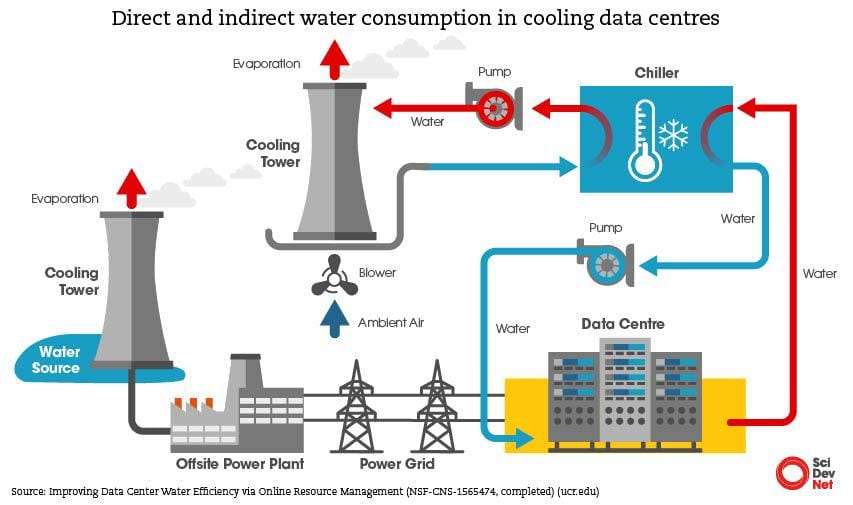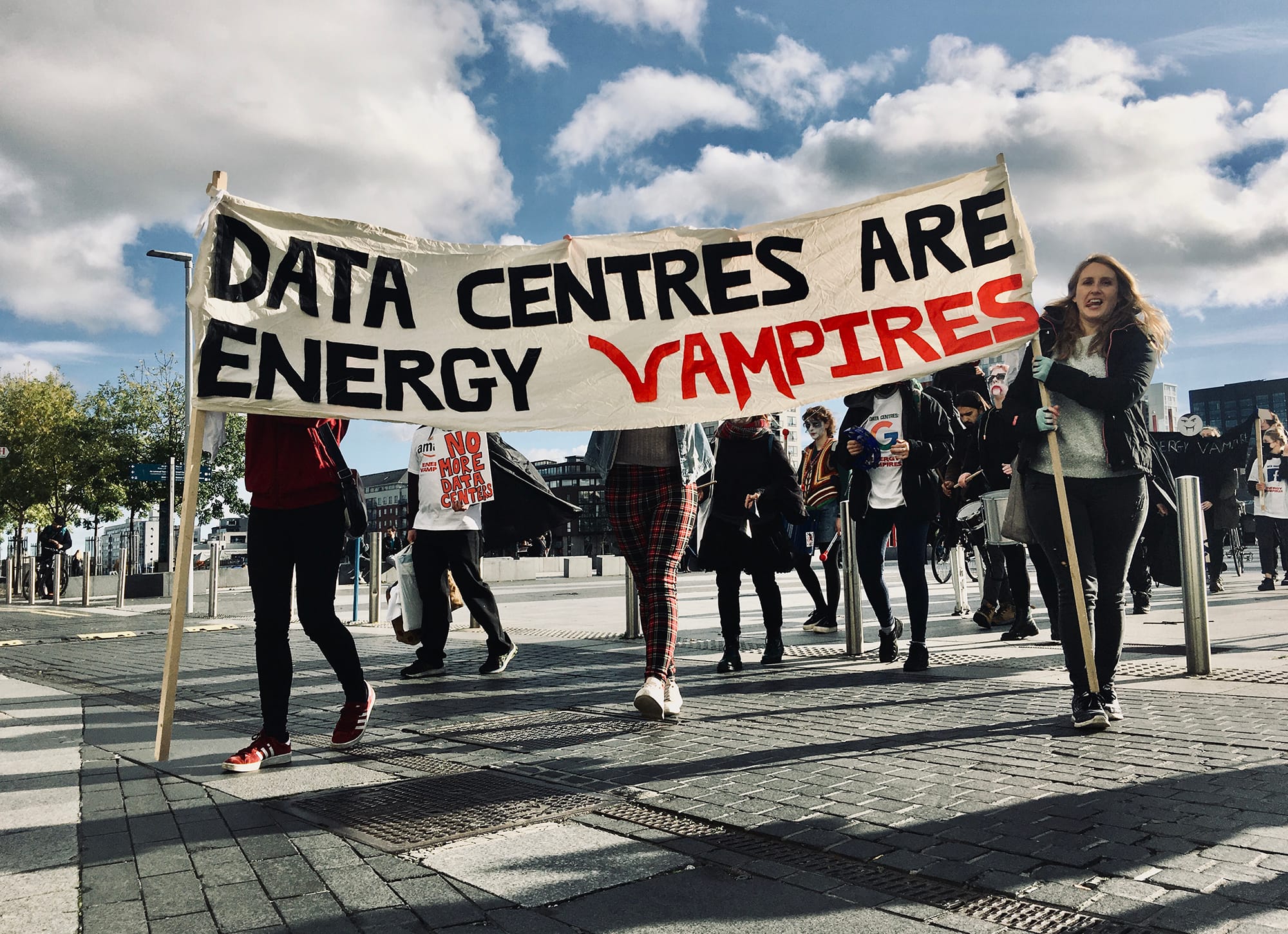The People vs Pollution
Why is Big Tech pouring money into wasteful data centres using billions of gallons of water? 🥵💦

Happy August! If you’re in the UK like me, congrats on summer finally arriving! After a wet start to the season, the sunshine couldn’t come quickly enough. But be careful what you wish for.
Take my country, Nigeria. Earlier this year temperatures surpassed 40C, an event which researchers say was made 10 times more likely by human-caused climate change and has been described as a “silent killer”. On top of this, people are struggling to access water clean enough to bathe in - let alone drink - even in affluent parts of Lagos, Nigeria’s largest city. The latest reason why? Lagos’ data centres, which are using vast amounts of water for electricity generation and cooling.
I’m Elfredah Kevin-Alerechi, an environmental investigative journalist and author of the fourth issue of The People, a bi-weekly newsletter from People vs Big Tech and the Citizens. This week, I’m looking at the environmental impact of Big Tech, from energy intensive AI to addictive algorithms.
Data centre infrastructure is expected to more than double by 2026. This is often blamed on the rise of generative AI. While there is good reason for this, we can’t forget the bigger picture. Big Tech is investing billions in wasteful data centres while failing to make their services more efficient, from reams of autoplay videos to endless advertising.
With the largest tech firms emitting 2-3 percent of the world’s carbon emissions - about the same amount as aviation ✈️ - and the ‘Big Five’ Tech companies consuming as much electricity as the population of New Zealand, the industry has A LOT to answer for.
These companies claim to care about our planet. But given their business models, can their environmental impact ever really be positive?
Trick or treat? 🧛♀️🦇⚰️

Google’s latest environmental report suggests it will now be difficult to achieve net-zero across its operations by 2030. Its carbon emissions have gone up by a whopping fifty percent since 2019. This is due to the vast amounts of power needed to run its data centres, with their energy needs exasperated by generative AI.
This year, they’ve spent billions on centres located everywhere from Finland to Malaysia. This requires huge water usage - in 2022 Google’s data centres consumed over 21 billion litres, enough to maintain 37 US golf courses. This graphic from SciDev.Net explains why:

But maybe it’s not all bad news. Google has also developed a less energy-intensive AI technology which can quickly predict long-term climate trends and weather.
This is undoubtedly useful. But at the same time: what’s the point if the company behind this technology is contributing to those same extreme climate events it's predicting?
Global Action Plan’s Oliver Hayes warns that AI's potential to solve climate issues could be "a PR trick" as more energy and water guzzling data centres are built. And that’s not all:
“The industry is very, very keen for us to focus on potential future benefits of AI but what we're actually seeing is that it's being used for harm straight away. Pretty much the first major clients the industry has been servicing are fossil fuel companies: we've seen Whistleblower reports from people within Microsoft saying we're effectively helping companies extract fossil fuels more efficiently with AI tools.”
Michelle Thorne from the Green Web Foundation, which advocates for a fossil fuel-free internet, wants big companies to commit to helping decarbonise the grid and resources rather than "greening their own operation." She said:
“Though some of these tech companies are running their data centres with renewable energy, which looks good on the surface, the issue is that they have taken the renewable capacity out of the grid, forcing local communities to use fossil fuels.”
Climate activists in Ireland aren’t falling for Big Tech’s greenwashing tricks, either. So much so that they staged a “vampire-themed” protest last Halloween against the energy sucking data centres:

The group behind the action was partly motivated by plans for three new Amazon data centres in Dublin, doubling the company's data centres on that site. According to Ireland's Central Statistics Office, power usage by data centres increased by 31 percent between 2021 and 2022, hitting a mind-blowing 18 percent of the total metered electricity consumption. This video gives a good sense of scale:
Data centres are monsters in terms of energy usage. They use the same power as a small town. Stop saving pictures of your dinner to the cloud! Ireland is playing a dangerous game with energy supply - hosting so many of them. pic.twitter.com/K2yh6diqEp
— Peter Dynes (@PGDynes) January 10, 2023
Similar protests have been seen around the world. And we are seeing some progress: Ireland, as well as countries such as Germany, Singapore and China, has introduced restrictions on new data centres to comply with environmental requirements, though they have faced industry backlash.
Back to business 🏢🏢
It’s undeniable that AI and the data centres needed to power it are a huge risk to our planet. But the business models used by Big Tech were energy intensive long before more recent generative AI developments.
From the vast amounts of data we store in the cloud, to addictive social media features like infinite scrolling and auto-play videos, Big Tech companies want us to be reliant on their services. But the energy required to power these services is affecting our planet too. As climate tech and AI entrepreneur Sherif Elsayed-Al put it:
“Data centres consume a lot of energy; they power energy intensive computing for generative AI and cryptocurrencies, in addition to everyday streaming and cloud services. Hyperscalers need to build them responsibly, only using added renewable generation and sustainable cooling. Tech companies need to put a stop to digital waste, designing services to be efficient and non-addictive is a start.”
And then there’s the big money-maker for most Big Tech companies. Advertising - and the huge amounts of data social media companies collect on you, which is then transferred across network infrastructure and data centres.
Artist and researcher Joana Moll’s project Carbolytics visualises the environmental costs of advertising technology (Ad Tech) and its opaque data collection practices.
Carbolytics analysed cookies belonging to one million websites, and identified more than 21 million cookies per single visit to all these websites - belonging to more than 1,200 different companies. This translates to an average of 197 trillion cookies per month, resulting in 11,442 monthly metric tonnes of CO2 emissions 🤯

Machine learning has long been used by the Ad Tech industry to mine our data from social media and other websites we use. I spoke to environmental scientist Gesa Marken, who co-authored a study looking at the (un-)sustainability of AI in the online marketing industry.
She’s concerned about not only the carbon footprint but the “material footprint” directly associated with Ad Tech, such as cooling water in data centres. I asked her what needs to change:
“Regulation of the use of AI in advertising could be quite helpful. There are people suggesting we should go back to contextual advertising, which is not personalised to the customer group…but related to the place where the advertising is displayed, for example if you go on a website about sports and then you’re getting advertisement based on that interest. But one could also argue that advertising in general is contributing to environmental risks, so we could also think about how much advertising is necessary and regulate that.”
Gesa also made the point that as well as the Ad Tech ecosystem consuming large amounts of energy, advertising itself is also generally designed to encourage us to…consume. And increased material consumption directly worsens climate breakdown and increases air pollution.
Ultimately though, it’s not us. It’s them. Emerging technologies like AI have potential to do as much good as harm. But the system as it stands and its gatekeepers do not work in favour of the planet, human rights, or us - The People.
Actions you can take ✊
- Reduce your digital footprint. This could look like: unsubscribing from unwanted newsletters and apps, getting rid of old emails, or minimising your cloud storage. You can get more tips like this in this excellent Guardian article.
- Keep an eye on your elected representatives’ stance on data centres, and resist it if you want to. In the UK for example, the newly elected government has proposed making it easier for companies to build new data centres, so watch this space.
- Are you a developer? Check out CodeCarbon, a Python package designed to help web developers measure and reduce the carbon emission impact of computer programmes.
People vs Big Tech is a collective of more than one hundred tech justice organisations around the world. This means we put together each newsletter with the help of the smartest and most respected experts in this field. Email bigtechstories@the-citizens.com if you have an idea for a Big Tech issue you'd like us to cover.

